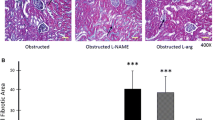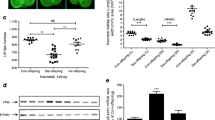Abstract
The study of kidney development at the cellular and molecular levels remains an active area of nephrology research. The functional integrity of the kidney depends on normal development as well as on physiological cell turnover. Apoptosis induction is essential for these mechanisms. A route to cell death revealed in the past decade shows that heat shock proteins (HSPs) and their cofactors are responsible for regulating the apoptotic pathway. Specifically, heat shock protein 70 (Hsp70), the most ubiquitous and highly conserved HSP, helps proteins adopt native conformation or regain function after misfolding. Hsp70 is an important cofactor for the function of Wilms’ tumour 1 (WT1) and suggests a potential role for this chaperone during kidney differentiation. In addition, we have demonstrated that WT1 expression is modulated by nitric oxide (NO) availability and Hsp70 interaction after neonatal unilateral ureteral obstruction. NO has been identified as playing an important role in the developing kidney. These findings suggest that Hsp70 and NO may play a critical and fundamental role in the capacity to modulate both apoptotic pathway and oxidative stress during kidney development. Furthermore, the design of experimental protocols that assess renal epithelial functionality in this context, could contribute to the understanding of renal development and alterations.

Similar content being viewed by others
References
Takayama S, Reed JC, Homma S (2003) Heat-shock proteins as regulators of apoptosis. Oncogene 22(56):9041–9047
Kelly KJ (2005) Heat shock (stress response) proteins and renal ischemia/reperfusion injury. Contrib Nephrol 148:86–106
Sharma D, Masison DC (2009) Hsp70 structure, function, regulation and influence on yeast prions. Protein Pept Lett 16(6):571–581
Murphy ME (2013) The HSP70 family and cancer. Carcinogenesis 34(6):1181–1188
Menke AL, Schedl A (2003) WT1 and glomerular function. Semin Cell Dev Biol 14(4):233–240
Maheswaran S, Englert C, Zheng G, Lee SB, Wong J, Harkin DP, Bean J, Ezzell R, Garvin AJ, McCluskey RT, DeCaprio JA, Haber DA (1998) Inhibition of cellular proliferation by the Wilms tumor suppressor WT1 requires association with the inducible chaperone Hsp70. Genes Dev 12(8):1108–1120
Mazzei L, García IM, Cacciamani V, Benardón ME, Manucha W (2010) WT-1 mRNA expression is modulated by nitric oxide availability and Hsp70 interaction after neonatal unilateral ureteral obstruction. Biocell 34(3):121–132
Johannesen J, Karlsen AE, Pociot F, Roenn SG, Nerup J (2003) Strain dependent rat iNOS promoter activity-correlation to identified WT1 transcription factor binding site. Autoimmunity 36(3):167–175
Solhaug MJ, Ballèvre LD, Guignard JP, Granger JP, Adelman RD (1996) Nitric oxide in the developing kidney. Pediatr Nephrol 10(4):529–539
Mazzei L, Manucha W (2013) WT-1 expression linked to nitric oxide availability during neonatal obstructive nephropathy. Adv Urol 2013:401750. doi:10.1155/2013/401750
Marra AN, Wingert RA (2014) Roles of iroquois transcription factors in kidney development. Cell Dev Biol 3(1):1000131
MrowkaC Schedl A (2000) Wilms’ tumor suppressor gene WT1: from structure to renal pathophysiologic features. J Am Soc Nephrol 11(16):S106–S115
Saint-Faust M, Boubred F, Simeoni U (2014) Renal development and neonatal adaptation. Am J Perinatol 31(9):773–780
Li X, Guo M, Shao Y (2013) Ultrastructural observations of programmed cell death during metanephric development in mouse. Microsc Res Tech 76(5):467–475
Lipschutz JH (1998) Molecular development of the kidney: a review of the results of gene disruption studies. Am J Kidney Dis 31(3):383–397
Toska E, Roberts SG (2014) Mechanisms of transcriptional regulation by WT1 (Wilms’ tumour 1). Biochem J 461(1):15–32
Pritchard-Jones K, Fleming Davidson SD, Bickmore W, Porteous D, Gosden C, Bard J, Buckler A, Pelletier J, Housman D, Van Heinigen V, Hastie N (1990) The candidate Wilms tumor gene is involved in genitourinary development. Nature 346(6280):194–197
Mundlos S, Pelletier J, Darveau A, Bachmann M, Winterpacht A, Zabel B (1993) Nuclear localization of the protein encoded by the Wilms’ tumor gene WT1 in embryonic and adult tissues. Development 119(4):1329–1341
Kreidberg JA, Sariola H, Loring JM, Maeda M, Pelletier J, Housman D, Jaenisch R (1993) WT-1 is required for early kidney development. Cell 74(4):679–691
Burrow C, Wilson PD (1993) A putative tumor-secreted growth factor activity required for primary culture of human nephroblast. Proc Natl Acad Sci USA 90(13):6066–6070
Rupprecht HD, Drummond IA, Madden SL, Rauscher FJ III, Sukhatme VP (1994) The Wilms’ tumor suppressor gene WT1 is negatively autoregulated. J Biol Chem 269(8):6198–6206
Gruss P, Walther C (1992) Pax in development. Cell 69(5):719–722
Dressler GR, Douglass EC (1992) Pax-2 is a DNA binding protein expressed in embryonic kidney and Wilms’ tumor. Proc Natl Acad Sci USA 89(4):1179–1183
Liapis H (2003) Biology of congenital obstructive nephropathy. Nephron Exp Nephrol 93(3):e87–e91
Manucha W, Vallés PG (2012) Apoptosis modulated by oxidative stress and inflammation during obstructive nephropathy. Inflamm Allergy Drug Targets 11(4):303–312
Mazzei LJ, García IM, Altamirano L, Docherty NG, Manucha W (2012) Rosuvastatin preserves renal structure following unilateral ureteric obstruction in the neonatal rat. Am J Nephrol 35(2):103–113
Hosono S, Gross I, English MA, Hajra KM, Fearon ER, Licht JD (2000) E-cadherin is a WT1 target gene. J Biol Chem 275(15):10943–10953
Manson SR, Niederhoff RA, Hruska KA, Austin PF (2011) The BMP-7-Smad1/5/8 pathway promotes kidney repair after obstruction induced renal injury. J Urol 185(6):2523–2530
Marcet-Palacios M, Davoine F, Adamko DJ, Moqbel R, Befus AD (2007) Human lymphocytes express the transcriptional regulator, Wilms tumor 1: the role of WT1 in mediating nitric oxide-dependent repression of lymphocyte proliferation. Biochem Biophys Res Commun 363(2):283–287
Ozdemir DD, Hohenstein P (2014) Wt1 in the kidney—a tale in mouse models. Pediatr Nephrol 29(4):687–693
Hohenstein P, Pritchard-Jones K, Charlton J (2015) The Yin and Yang of kidney development and Wilms’ tumors. Genes Dev 29(5):467–482
Astuti D, Morris MR, CooperWN Staals RH, Wake NC, Fews GA, Gill H, Gentle D, Shuib S, Ricketts CJ et al (2012) Germline mutations in DIS3L2 cause the Perlman syndrome of overgrowth and Wilms tumor susceptibility. Nat Genet 44:277–284
Nagalakshmi VK, Ren Q, Pugh MM, Valerius MT, McMahon AP, Yu J (2011) Dicer regulates the development of nephrogenic and ureteric compartments in the mammalian kidney. Kidney Int 79:317–330
Koller K, Das S, Leuschner I, Korbelius M, Hoefler G, Guertl B (2013) Identification of the transcription factor HOXB4 as a novel target of miR-23a. Genes Chromosom Cancer 52:709–715
Kang SS, Song JH, Lee MY, Kang YH, Lim SS, Ryu SY, Jung JY (2011) Developmental immunolocalization of heat shock protein 70 (HSP70) in epithelial cell of rat kidney. Histol Histopathol 26(11):1363–1373
Beissinger M, Buchner J (1998) How chaperones fold proteins. Biol Chem 379(3):245–259
Fink AL (1999) Chaperone-mediated protein folding. Physiol Rev 79(2):425–449
Hartl FU (1996) Molecular chaperones in cellular protein folding. Nature 381(6583):571–579
Luders J, Demand J, Schonfelder S, Frien M, Zimmerman R, Hohfeld J (1998) Cofactor-induced modulation of the functional specificity of the molecular chaperone Hsc70. Biol Chem 379(10):1217–1226
Beck FX, Neuhofer W, Müller E (2000) Molecular chaperones in the kidney: distribution, putative roles, and regulation. Am J Physiol Renal Physiol 279(2):F203–F215
Vallés P, Jorro F, Carrizo L, Manucha W, Oliva J, Cuello-Carrión DF, Ciocca DR (2003) Heat shock proteins HSP27 and HSP70 in unilateral obstructed kidneys. Pediatr Nephrol 18(6):527–535
Manucha W, Carrizo L, Ruete C, Molina H, Vallés P (2005) Angiotensin II type I antagonist on oxidative stress and heat shock protein 70 (HSP 70) expression in obstructive nephropathy. Cell Mol Biol (Noisy-le-grand) 51(6):547–555
Carrizo LC, Ruete CM, Manucha WA, Ciocca DR, Vallés PG (2006) Heat shock protein 70 expression is associated with inhibition of renal tubule epithelial cell apoptosis during recovery from low-protein feeding. Cell Stress Chaperones 11(4):309–324
Bocanegra V, Manucha W, Peña MR, Cacciamani V, Vallés PG (2010) Caveolin-1 and Hsp70 interaction in microdissected proximal tubules from spontaneously hypertensive rats as an effect of Losartan. J Hypertens 28(1):143–155
García IM, Altamirano L, Mazzei L, Fornés M, Cuello-Carrión FD, Ferder L, Manucha W (2014) Vitamin D receptor-modulated Hsp70/AT1 expression may protect the kidneys of SHRs at the structural and functional levels. Cell Stress Chaperones 19(4):479–491
Zhou Y, Mao H, Li S, Cao S, Li Z, Zhuang S, Fan J, Dong X, Borkan SC, Wang Y, Yu X (2010) HSP72 inhibits Smad3 activation and nuclear translocation in renal epithelial-to-mesenchymal transition. J Am Soc Nephrol 21(4):598–609
O’Neill S, Harrison EM, Ross JA, Wigmore SJ, Hughes J (2014) Heat-shock proteins and acute ischaemic kidney injury. Nephron Exp Nephrol 126(4):167–174
Manucha W (2014) HSP70 family in the renal inflammatory response. Inflamm Allergy Drug Targets 13(4):235–240
Mazzei L, Docherty NG, Manucha W (2015) Mediators and mechanisms of heat shock protein 70 based cytoprotection in obstructive nephropathy. Cell Stress Chaperones 20(6):893–906
Manucha W, Ritchie B, Ferder L (2015) Hypertension and insulin resistance: implications of mitochondrial dysfunction. Curr Hypertens Rep 17(1):504. doi:10.1007/s11906-014-0504-2
Vallés P, Manucha W (2207) Nitric oxide in the kidney: physiological roles and regulation. In: Gimenéz MS, Gómez NN (eds) Advances in chemistry and biology of nitric oxide. Research Signpost, Kerala, pp 53–80 (ISBN 978-81-308-0187-2)
Gregory CD, Pound JD (2011) Cell death in the neighbourhood: direct microenvironmental effects of apoptosis in normal and neoplastic tissues. J Pathol 223(2):177–194
Kim YM, Bombeck CA, Billiar TR (1999) Nitric oxide as a bifunctional regulator of apoptosis. Circ Res 84(3):253–256
Mosser DD, Caron AW, Bourget L, Denis-Larose C, Massie B (1997) Role of the human heat shock protein hsp70 in protection against stress-induced apoptosis. Mol Cell Biol 17(9):5317–5327
Manucha W, Kurbán F, Mazzei L, Benardón ME, Bocanegra V, Tosi MR, Vallés P (2011) eNOS/Hsp70 interaction on rosuvastatin cytoprotective effect in neonatal obstructive nephropathy. Eur J Pharmacol 650(2–3):487–495
Ballèvre L, Solhaug MJ, Guignard JP (1996) Nitric oxide and the immature kidney. Biol Neonate 70(1):1–14
Vicencio A, Bidmon B, Ryu J, Reidy K, Thulin G, Mann A, Gaudio KM, Kashgarian M, Siegel NJ (2003) Developmental expression of HSP-72 and ischemic tolerance of the immature kidney. Pediatr Nephrol 18(2):85–91
Molina MN, Ferder L, Manucha W (2016) Emerging role of nitric oxide and heat shock proteins in insulin resistance. Curr Hypertens Rep 18(1):1. doi:10.1007/s11906-015-0615-4
Author information
Authors and Affiliations
Corresponding author
Ethics declarations
Conflict of interest
The authors declare that they have no conflicts of interest, financial or otherwise, related to the content of this article.
Ethical approval
This article does not contain any studies with human participants performed by any of the authors.
Rights and permissions
About this article
Cite this article
Mazzei, L., Manucha, W. Growing evidence suggests WT1 effects in the kidney development are modulated by Hsp70/NO interaction. J Nephrol 30, 11–18 (2017). https://doi.org/10.1007/s40620-016-0302-9
Received:
Accepted:
Published:
Issue Date:
DOI: https://doi.org/10.1007/s40620-016-0302-9




